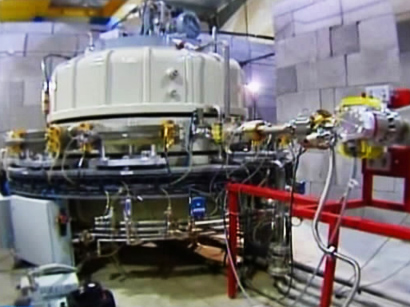Head of the Atomic Energy Organization of Iran (AEOI) Fereidoun Abbasi announced that the country plans to design and build a center equipped with a fixed gamma radiation system in Bonab city, Northwestern Iran, in the near future, Fars news agency reported.
"The building of this center is being constructed and will be ready for inauguration by the end of the first half of this (Iranian) year (end of summer) after the necessary equipments are installed," Abbasi told reporters in Bonab city, East Azarbaijan province on Sunday night.
He said that Iran will be able to mass-produce portable radiation systems after launching the fixed system and can send them all over the country.
Gamma radiation, also known as gamma rays, refer to electromagnetic radiation of high frequency and therefore high energy per photon. They are classically produced by the decay from high energy states of atomic nuclei (gamma decay), but are also created by other processes.
Natural sources of gamma rays on Earth include gamma decay from naturally occurring radioisotopes, and secondary radiation from atmospheric interactions with cosmic ray particles.
Rare terrestrial natural sources produce gamma rays that are not of a nuclear origin, such as lightning strikes and terrestrial gamma-ray flashes. Gamma rays are produced by a number of astronomical processes in which very high-energy electrons are produced, that in turn cause secondary gamma rays by the mechanisms of bremsstrahlung, inverse Compton scattering and synchrotron radiation.
Gamma-induced molecular changes can also be used to alter the properties of semi-precious stones, and is often used to change white topaz into blue topaz.
Non-contact industrial sensors used in the Refining, Mining, Chemical, Food, Soaps and Detergents, and Pulp and Paper industries, in applications measuring levels, density, and thicknesses commonly use sources of gamma. Typically these use Co-60 or Cs-137 isotopes as the radiation source.
Gamma radiation is often used to kill living organisms, in a process called irradiation. Applications of this include sterilizing medical equipment (as an alternative to autoclaves or chemical means), removing decay-causing bacteria from many foods or preventing fruit and vegetables from sprouting to maintain freshness and flavor.
Despite their cancer-causing properties, gamma rays are also used to treat some types of cancer, since the rays kill cancer cells as well.
In the procedure called gamma-knife surgery, multiple concentrated beams of gamma rays are directed on the growth in order to kill the cancerous cells. The beams are aimed from different angles to concentrate the radiation on the growth while minimizing damage to surrounding tissues.
Gamma rays are also used for diagnostic purposes in nuclear medicine in imaging techniques. A number of different gamma-emitting radioisotopes are used. For example, in a PET scan a radiolabeled sugar called fludeoxyglucose emits positrons that are converted to pairs of gamma rays that localize cancer (which often takes up more sugar than other surrounding tissues).
The most common gamma emitter used in medical applications is the nuclear isomer technetium-99m which emits gamma rays in the same energy range as diagnostic X-rays. When this radionuclide tracer is administered to a patient, a gamma camera can be used to form an image of the radioisotope's distribution by detecting the gamma radiation emitted.
Depending on what molecule has been labeled with the tracer, such techniques can be employed to diagnose a wide range of conditions (for example, the spread of cancer to the bones in a bone scan).






